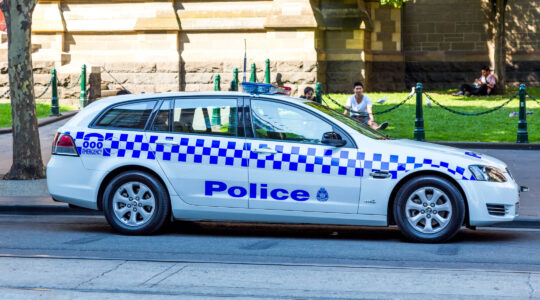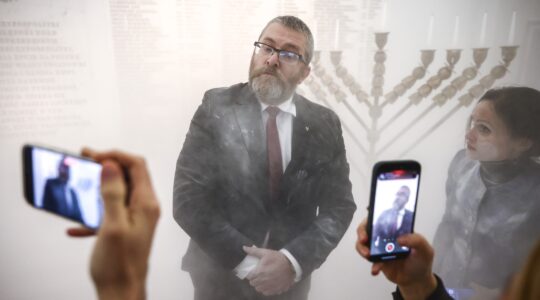
The $185 million Joseph and Wolf Lebovic Jewish Community Campus is one of the most ambitious Jewish projects ever undertaken in Canada. (Shai Gil Photography)
TORONTO (JTA) – Standing in the sprawling new $185 million Jewish community complex just north of Toronto, Taali Lester Tollman sweeps her outstretched arm in a wide arc.
“Just a few years ago,” says Tollman, UJA Federation of Greater Toronto’s vice president of marketing, “all this was pasture.”
Actually it was woodland, but no matter. On the space now stands one of the most ambitious Jewish projects ever undertaken in Canada.
Spread across 50 acres, the Joseph and Wolf Lebovic Jewish Community Campus is testament to the dramatic growth of Toronto’s Jewish population. The 200,000-square-foot complex, which officially opened Sunday, houses social service agencies, conference facilities, a Conservative egalitarian synagogue with afternoon classes, a day care and preschool, a theater and art gallery, a Jewish high school (with an elementary school slated next year), a residence for developmentally challenged adults and a gleaming 10,000-square-foot fitness center with three saltwater pools. There is underground parking for 350 vehicles and plans for an infirmary staffed by 10 doctors. It’s all set on grounds wound with pathways and gardens.
“It’s absolutely unique in North America,” David Sadowski, UJA Federation’s man in charge of Jewish community properties, told JTA. “And it came in on budget and on time.”
Situated about four miles north of the Toronto city limits in the city of Vaughan, the campus will serve a Jewish community that has surged in numbers in the past decade. Greater Toronto, including several suburban municipalities within York Region north of the city, continues to be the fastest-growing major Jewish population center in Canada.
Toronto’s northern suburbs have become a magnet for newcomers from other Canadian cities, notably Montreal and Winnipeg, and for immigrants from Israel, South Africa, Russia and Argentina. The sprawling northern region is now home to about 80,000 Jews, or 40 percent of the Toronto region’s Jewish population, according to Canadian Jewish demographer Charles Shahar, research coordinator in the community planning and allocations department at Montreal’s Federation CJA.
That’s up from 60,000 in 2001 and only 1,500 or so Jews in 1971, when the area was largely rural woodland. In the decades since, the farms and trees have been transformed into suburban subdivisions, many of them heavily Jewish.
Rebecca Soberman, her husband and infant daughter moved from northern Toronto into a neighborhood known as Thornhill Woods, a short drive from the Lebovic campus, in early 2006 amid the dust and mud of an unfinished development. Her street was finished only 18 months ago.
“We did it because it’s a young community and we wanted to be around other young people,” said Soberman, now a mother of two.
Pushing ever northward from the city in search of affordable homes and open spaces, young Jewish families and newcomers to the country already are treating the new Jewish community campus as a hub, according to Tollman.
“They’re no longer looking for cathedral synagogues,” she said. “They want more, and they want it in a one-stop setting. This is how the community is now expressing its Jewishness.”
As for the ubiquitous Chabad, fully half of the 20 or so Chabad-Lubavitch centers in Toronto and its suburbs are less than five years old. There are eight Chabad centers in the York Region alone, including one for former Israelis.The Jewish community purchased the land for the new community campus in 1999, and in 2000 launched a $400 million, decade-long campaign to build or revitalize three JCCs in greater Toronto, including the new campus. To date, $300 million has been raised.
The provincial government of Ontario contributed a no-strings grant of $15 million to the new campus, and the federal government kicked in matching funds worth up to $15 million. The Lebovic family donated $20 million to the project, and promised another $500,000 if the street accessing the campus was named for them. It was. A nearby boulevard is named for Ilan Ramon, the Israeli astronaut who perished in the 2003 Columbia space shuttle crash. Down the street is Ner Israel Drive, home to the eponymous yeshiva.
Dozens of family programs already are on the schedule for the new community campus, including ones in Hebrew and Russian. The gym, which opened in June, already has 4,500 members.
While the Jewish population of Canada is growing relatively modestly, Toronto’s Jewish community is booming.
National numbers are hard to come by because two years ago the federal government eliminated a long-form census that contained a question about religion, and the results from a voluntary Jewish National Household Survey won’t be known for a few months. Shahar says his projections show 385,200 Jews in Canada as of last year, up from 370,515 in the 2001 Canadian census — a 4 percent increase over a decade.
But Shahar says Toronto is projected to have grown 10 percent over the same period, to 196,400 from 179,105 in 2001. The real boom has been in York Region, where two municipalities have seen substantial Jewish growth, according to Shahar: Richmond Hill, to 16,000 from 11,000 a decade ago, and Vaughan, where the Jewish population has mushroomed to 51,000 from 34,300. Shahar attributes the growth to immigration, migration within Canada and Jews moving from the city of Toronto to the suburbs.
At the same time, however, the boom north of Toronto has not translated into dwindling numbers in the city itself. In fact, downtown Toronto has seen a Jewish revival of late. UJA estimates at least 21,000 Jews now live south of midtown; Shahar says about 5,800 Jews live in the downtown area.
In recent years, three new congregations have sprung up downtown, and a plethora of Jewish recreational, cultural and educational activities are available there. Jewish community officials credit young Jews — singles and young families — with keeping up the city’s Jewish vitality, as they move to places that their immigrant grandparents first lived when they came here. In downtown’s famed Kensington Market district, for example, three creaky, musty synagogues dating to the early 1900s now draw mostly young worshipers.
“There’s definitely been a Jewish renaissance downtown,” said Sharoni Sibony, manager of Jewish life at the inner-city Miles Nadal JCC. “It’s close to work for a lot of people who aren’t ready for the suburbs yet.”
JTA has documented Jewish history in real-time for over a century. Keep our journalism strong by joining us in supporting independent, award-winning reporting.





